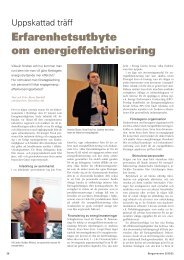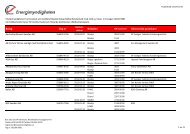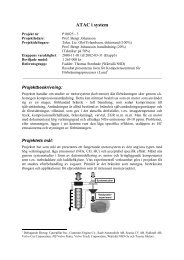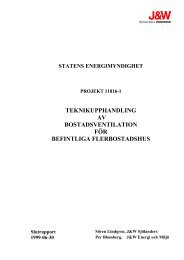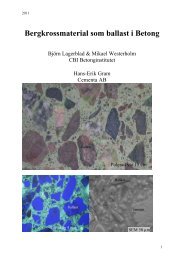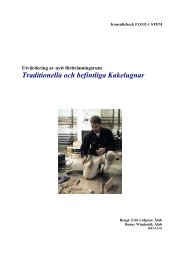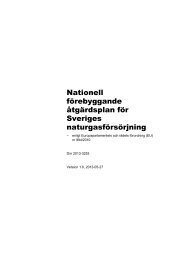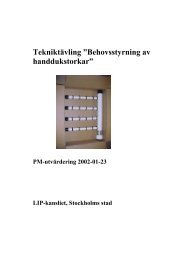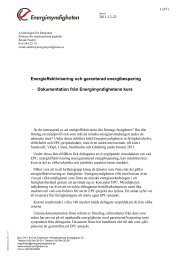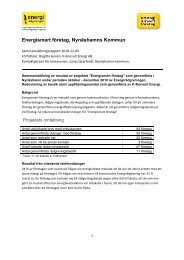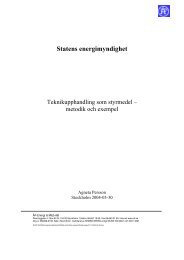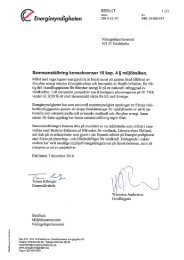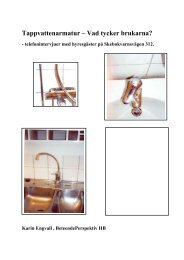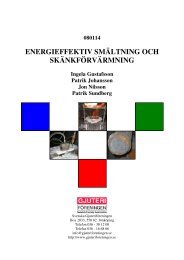Förädling Bränslekvalitet Åkerbränslen - Energimyndigheten
Förädling Bränslekvalitet Åkerbränslen - Energimyndigheten
Förädling Bränslekvalitet Åkerbränslen - Energimyndigheten
Create successful ePaper yourself
Turn your PDF publications into a flip-book with our unique Google optimized e-Paper software.
to the manual method currently in use where samples are dried and the weight loss<br />
measured. This method has limitations in regard to representativity, is relatively<br />
labour intensive and does not provide answers until up to 24 hours later. Any<br />
method that is significantly better in these regards has great potential for use both<br />
in price calculations for fuel deliveries and for input signals to control algorithms<br />
for boiler operations. NIR technology was the main area for study for these<br />
applications and showed good results, but so too did RF technology (Radio<br />
Frequency). One prototype for NIR measurement of fuel deliveries was developed<br />
and evaluated in practical operations. The method is based on a measuring probe<br />
installed on a crane jib; the probe is inserted into the fuel upon which NIR<br />
adsorption by the fuel is determined. The method requires quite a lot of calibration<br />
work in order to cover different fuel types and moisture levels, and calibration is<br />
in principal tied to the measurement system concerned. Under these circumstances<br />
the NIR method level of uncertainty proved to be distinctly lower than the<br />
reference method’s; less than two percentage points compared to four or five<br />
percentage points. A specification has been established for the NIR method as<br />
support for price calculation, and the method is awaiting the imminent approval of<br />
the dominant player on the market, the Swedish Timber Measurement<br />
Association. NIR measurement of moisture levels directly in the fuel feed to the<br />
boiler for use as an input signal to the control system was also studied at two<br />
plants. Good results were also achieved here, chiefly in regard to improved<br />
control of bed temperatures that lead to lower emissions of CO and NOx, and<br />
higher power output, all of considerable economic significance. The technology<br />
can be considered commercially viable, and several installations have been sold.<br />
Requirements for further development pertain mainly to calibration methods and<br />
automation of the probe motion. The RF method has not yet shown the same<br />
immediate potential, but some development work continues and the method has<br />
not been written off.<br />
The control of pellet matrix temperatures is under study as a possible method<br />
of ensuring the stable pressing of good quality pellets from straw fuels. Raw<br />
materials of this type today often present problems with the production of pellets<br />
of uneven quality in regard to durability and density, and this has a clear<br />
connection to the temperature in the matrix at the time of pressing. Because this<br />
temperature is a result of the raw material’s moisture content, and the possible<br />
addition of steam, and is not possible to control today, it is probable that<br />
temperatures are not optimal from production and quality standpoints. The aim of<br />
the project, which was begun recently, is to investigate whether controlling matrix<br />
temperature to optimum values for the raw materials concerned can provide<br />
improved production uniformity, better quality and lower energy consumption.<br />
Pellet combustion characteristics are being studied in a project with the<br />
overarching aim of combining research into pellets production with research<br />
into pellets combustion. The project will also develop principles and<br />
documentation for quality assurance systems in respect of the entire delivery<br />
chain from raw material to burner. The project is expected to contribute to an<br />
increase in knowledge of the characteristics of pellets produced from different raw<br />
materials. Combustion trials with pellets from different raw materials are expected<br />
13



